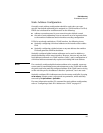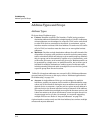
3-8
IPv6 Addressing
IPv6 Address Sources
servers. These lifetimes cannot be reset using control from the switch console
or SNMP methods. Refer to “Preferred and Valid Address Lifetimes” on page 3-
25.
Stateful (DHCPv6) Address Configuration
Stateful addresses are defined by a system administrator or other authority,
and automatically assigned to the switch and other devices through the
Dynamic Host Configuration Protocol (DHCPv6). Generally, DHCPv6 should
be applied when you want specific, non-default addressing to be assigned
automatically. For IPv6, DHCP use is indicated for conditions such as the
following:
■ address conventions used in your network require defined control
■ static addressing is not feasible due to the number of nodes in the network
■ automatic assignment of multiple IPv6 addresses per interfaces is needed
■ automatic configuration of IPv6 access to DNS, SNTP, or TimeP servers
To implement stateful address configuration:
■ The DHCPv6 server must be configured and accessible to the switch,
either on the same VLAN or through an IPv6 router configured with DHCP
Relay to support service requests from the switch.
Note DHCPv6 relay may not currently be available in some IPv6 routers.
■ DHCPv6 addressing must be enabled per-VLAN on the switch.
Note that IPv6 router advertisements (RAs) can also include instructions to
clients to use DHCPv6 resources. Refer to the documentation for your IPv6
router.
If you want to use DHCPv6 in a dual-stack environment, you will need both
DHCPv4 and DHCPv6 server access. Also, further developments in DHCP
services are likely to mean new capabilities affecting DHCPv6 deployments.
For related information, refer to:
■ RFC 3315: “Dynamic Host Configuration Protocol for IPv6 (DHCPv6)”
■ RFC 3041: “Privacy Extensions for Stateless Address Autoconfiguration
in IPv6”


















